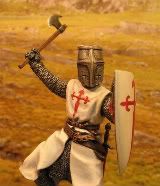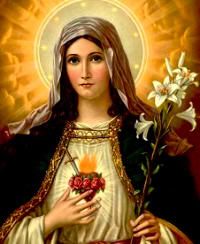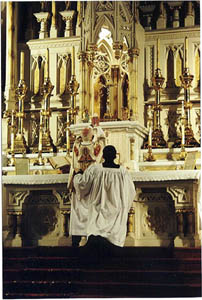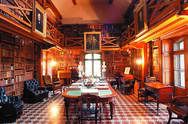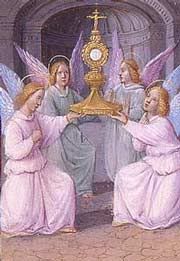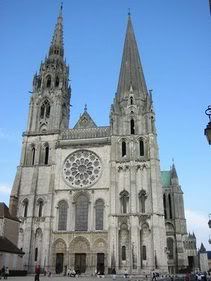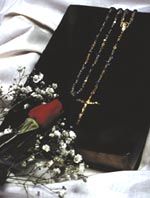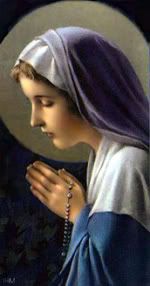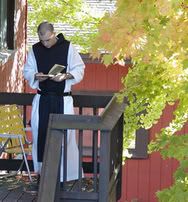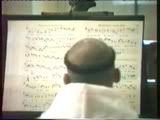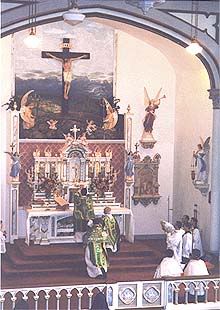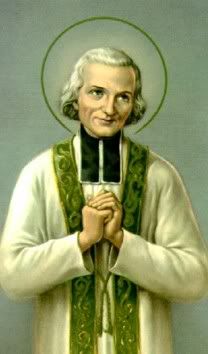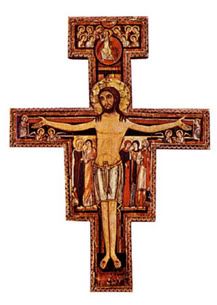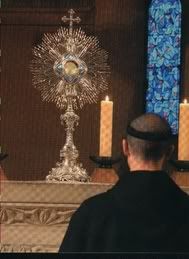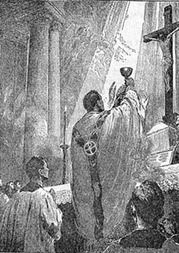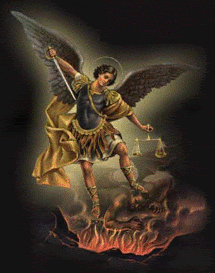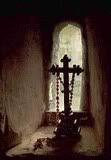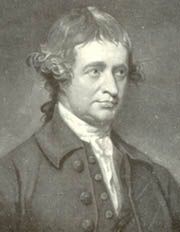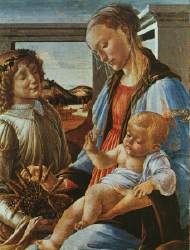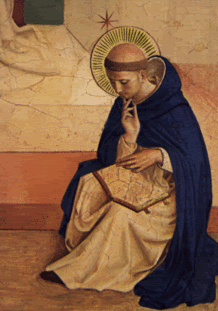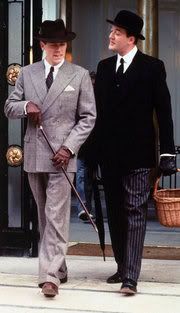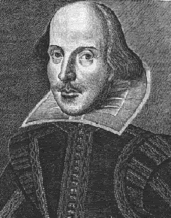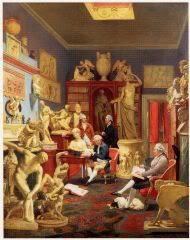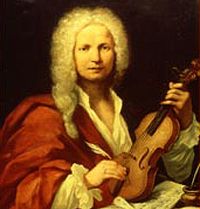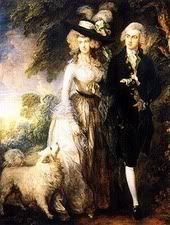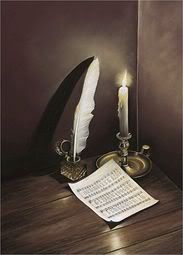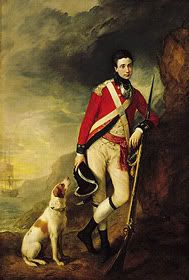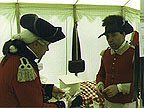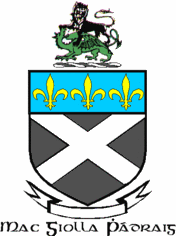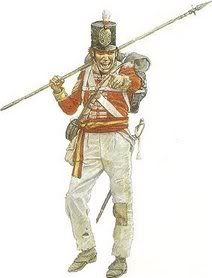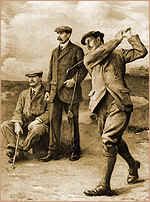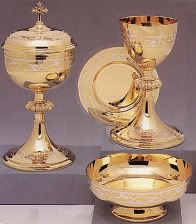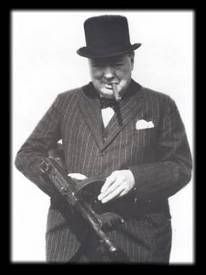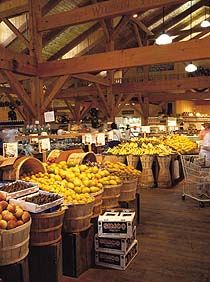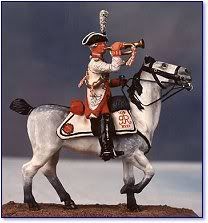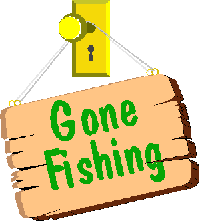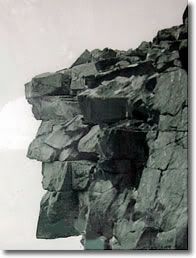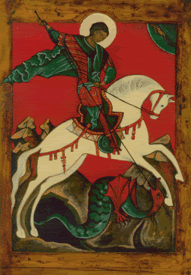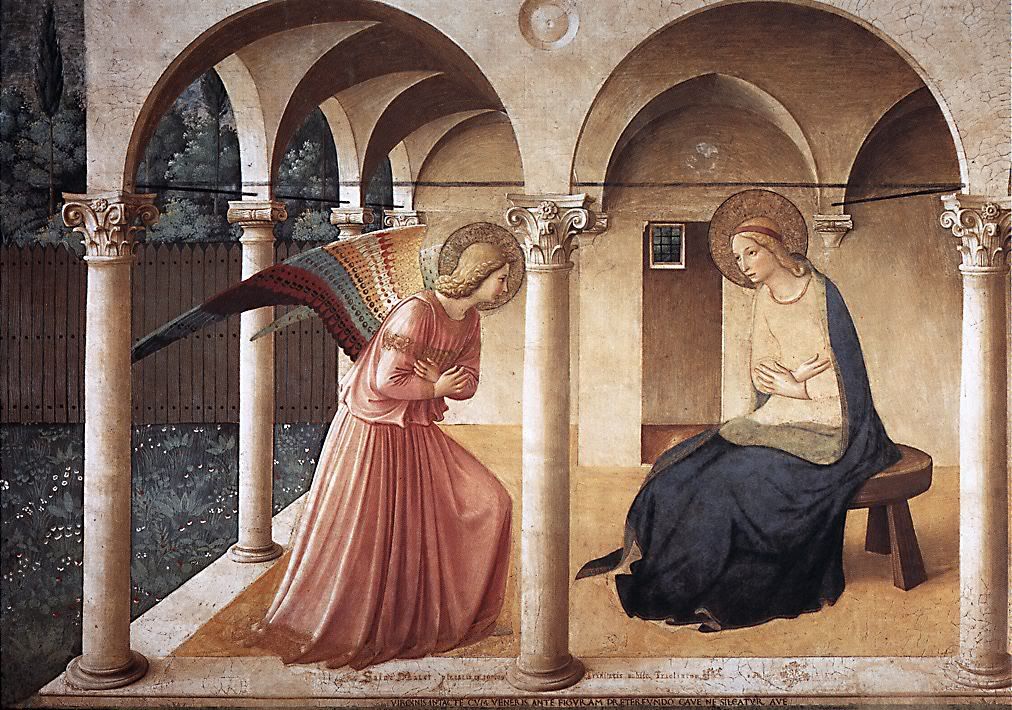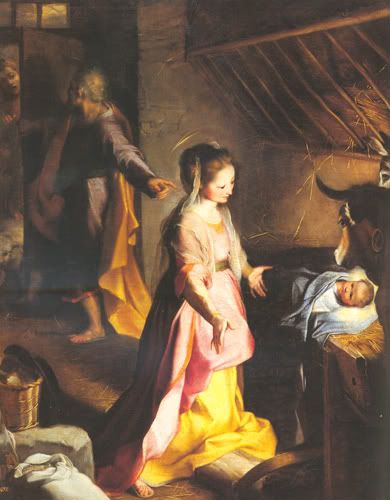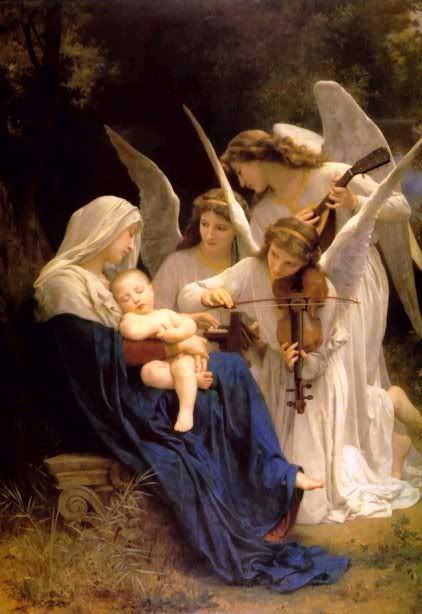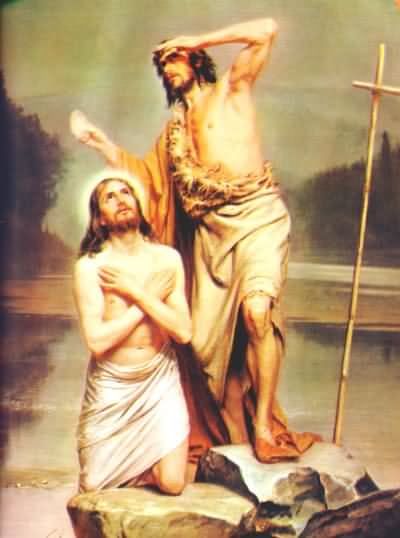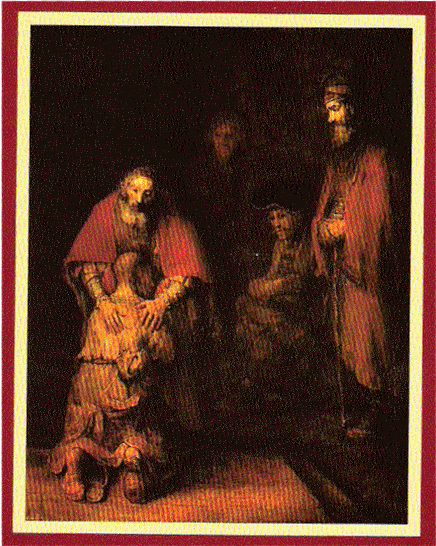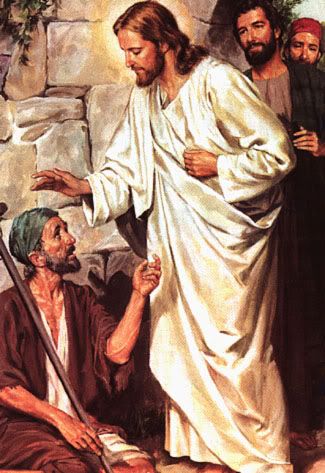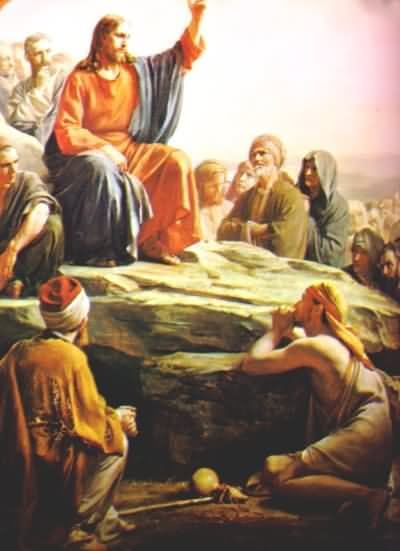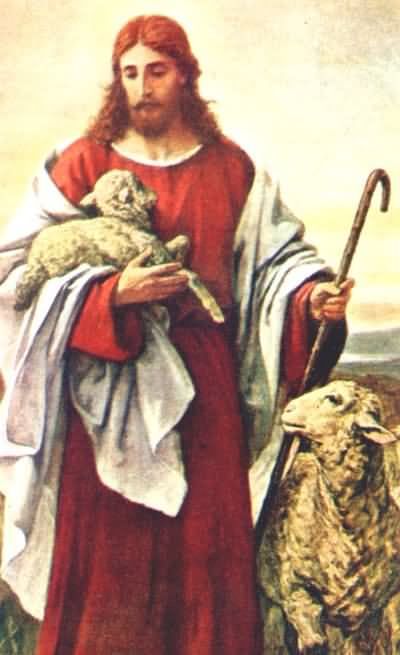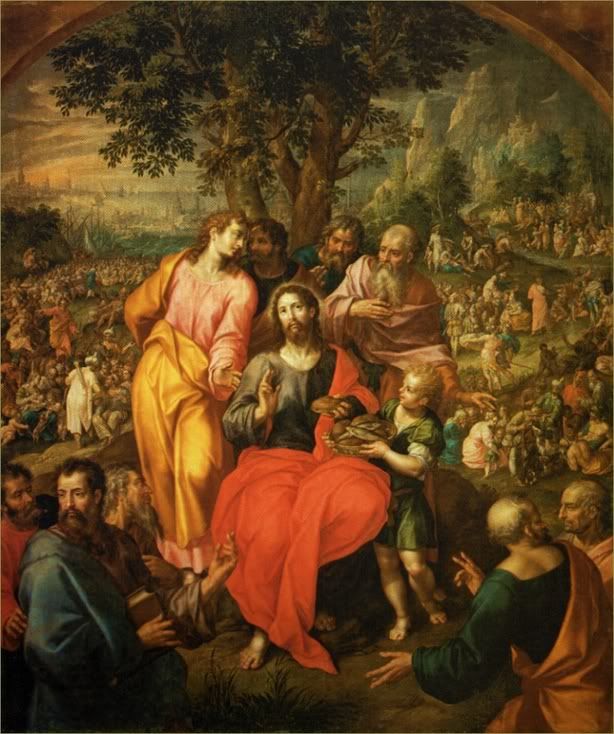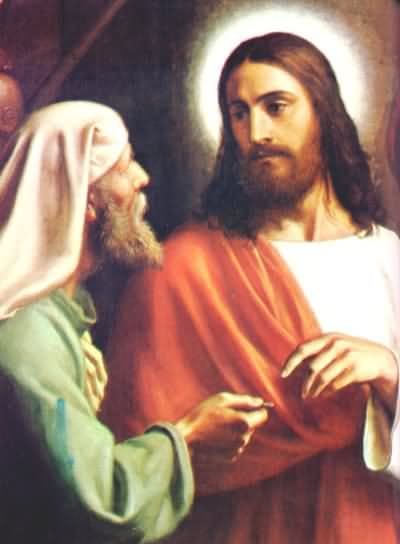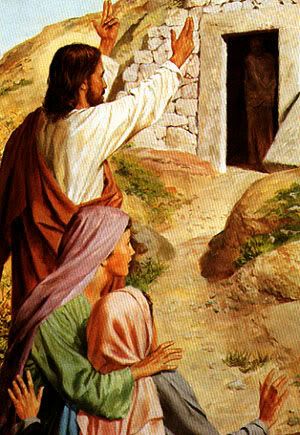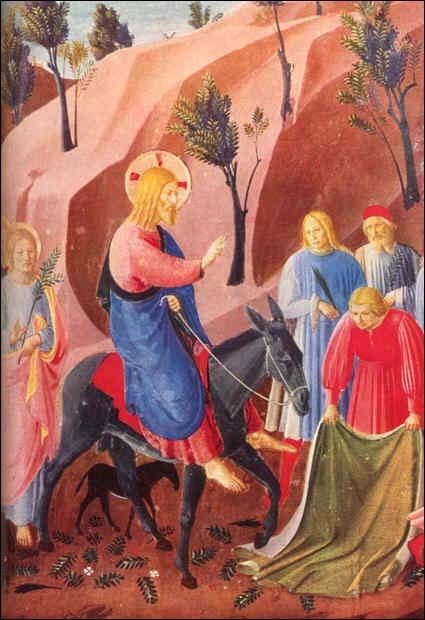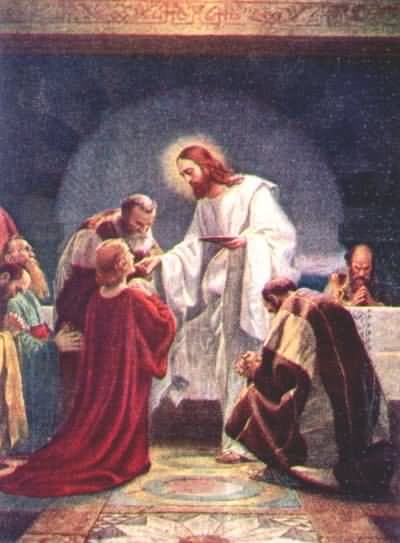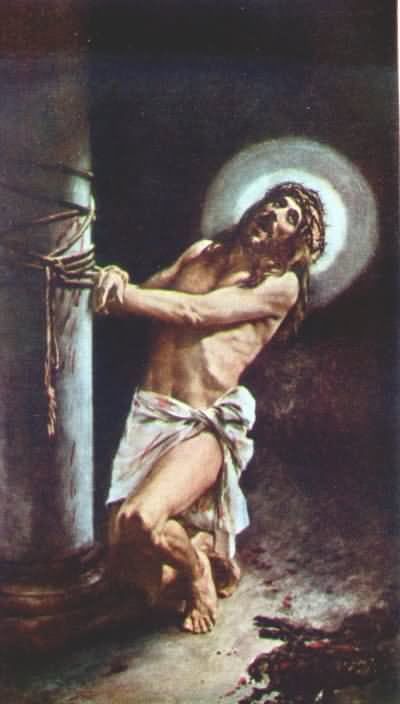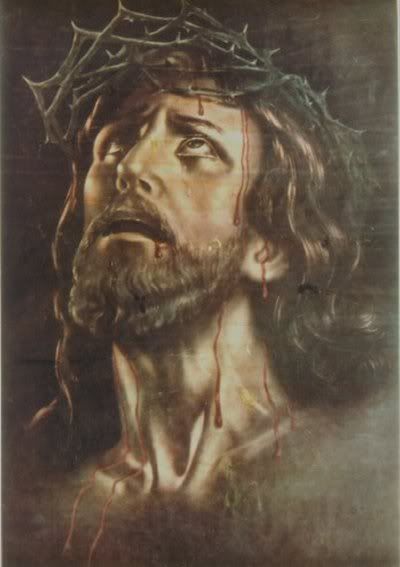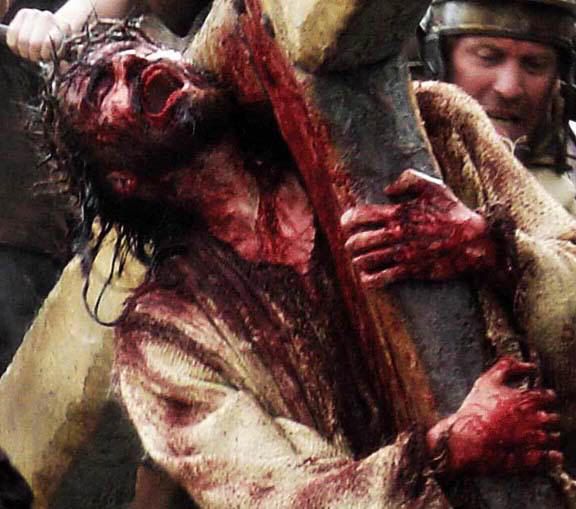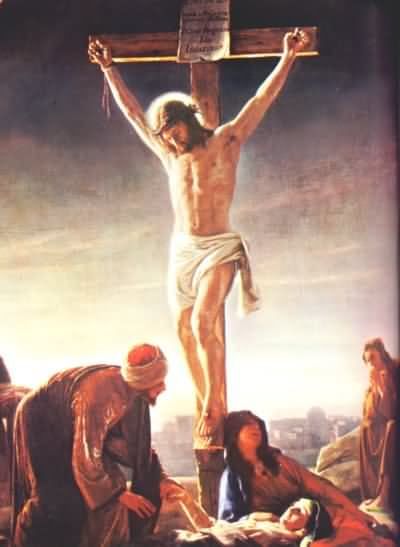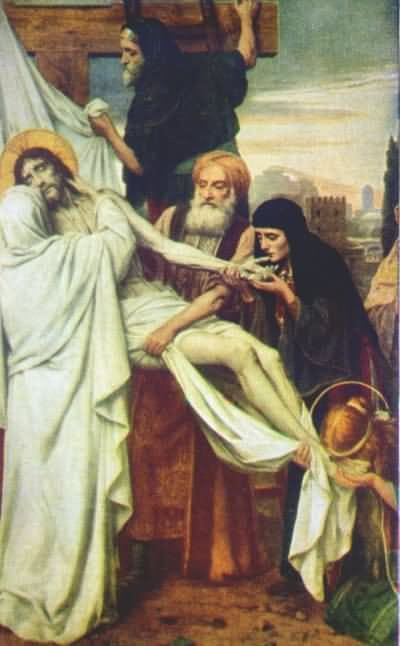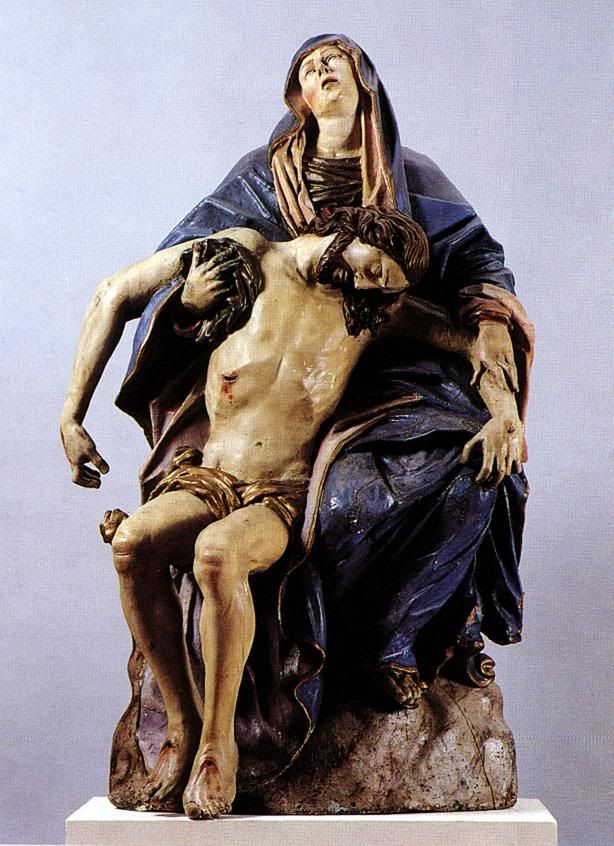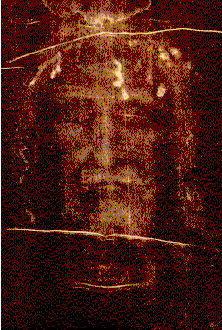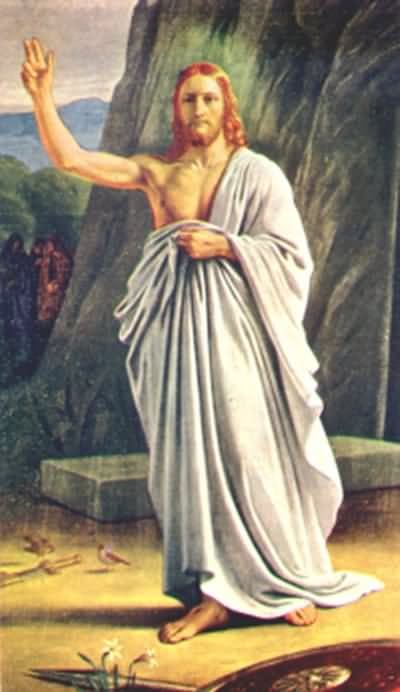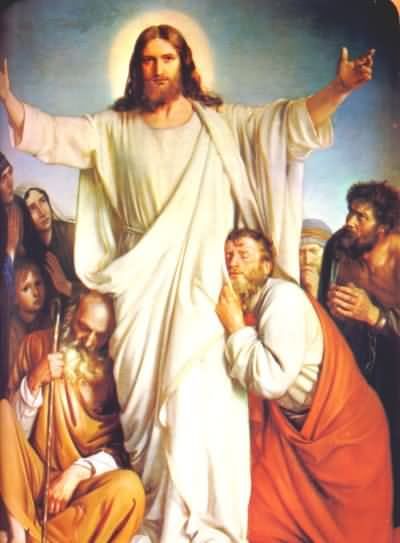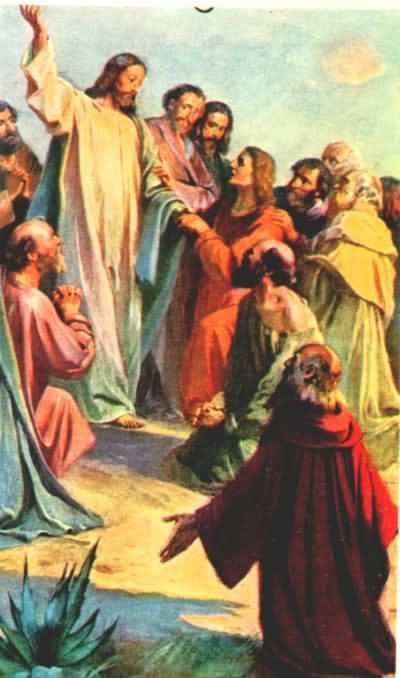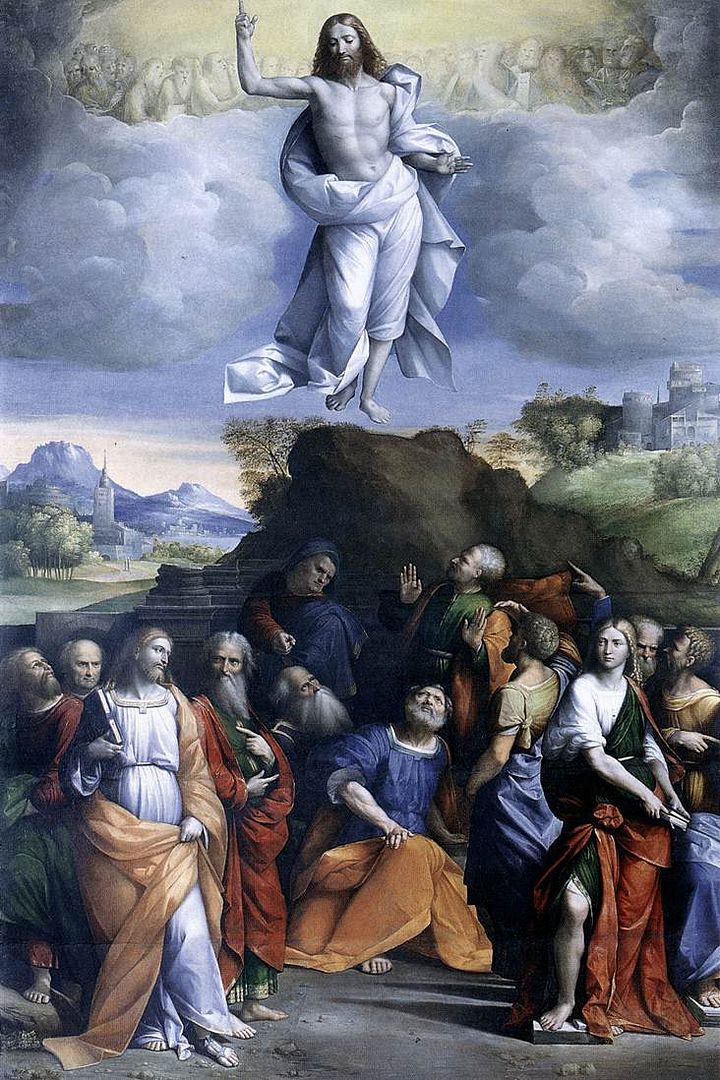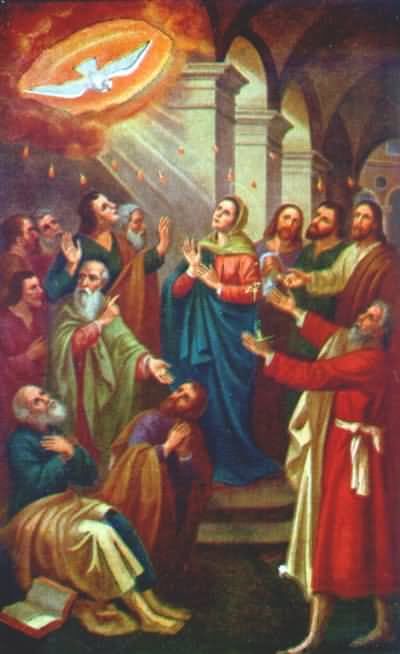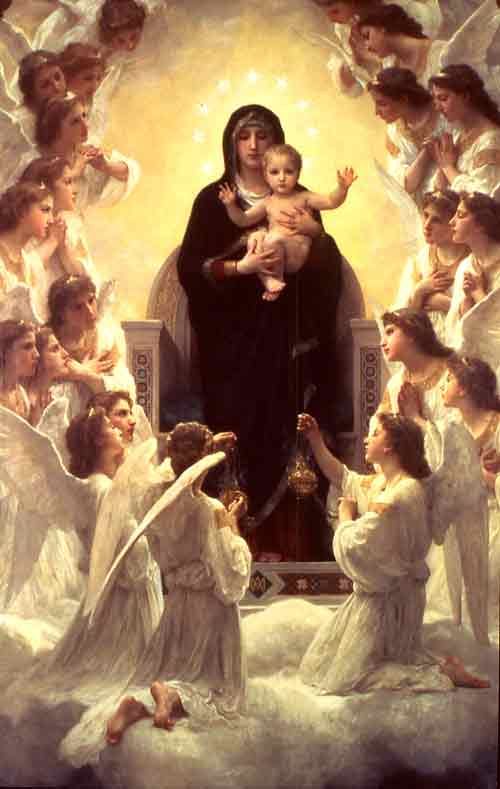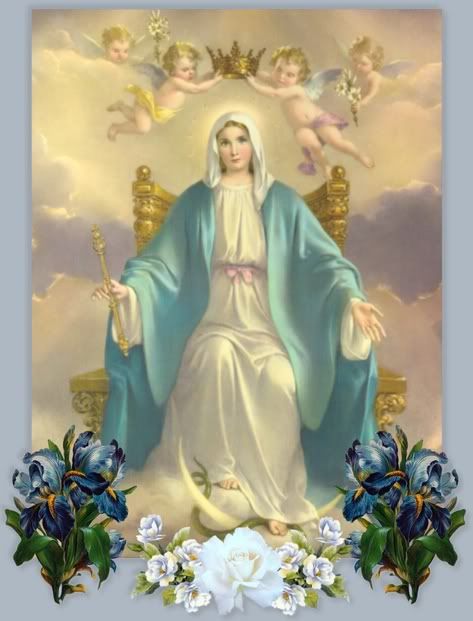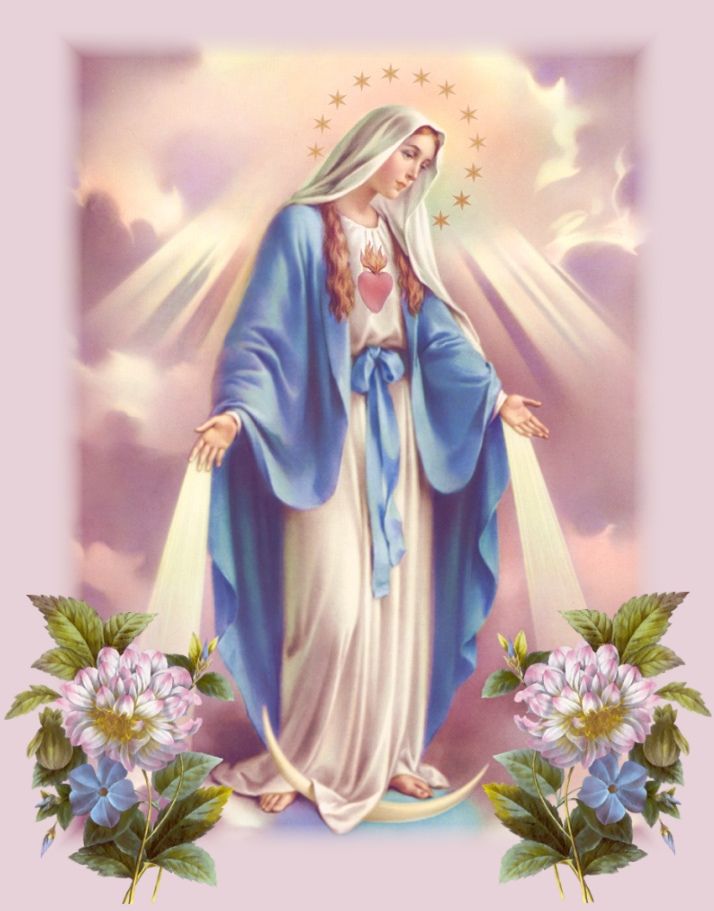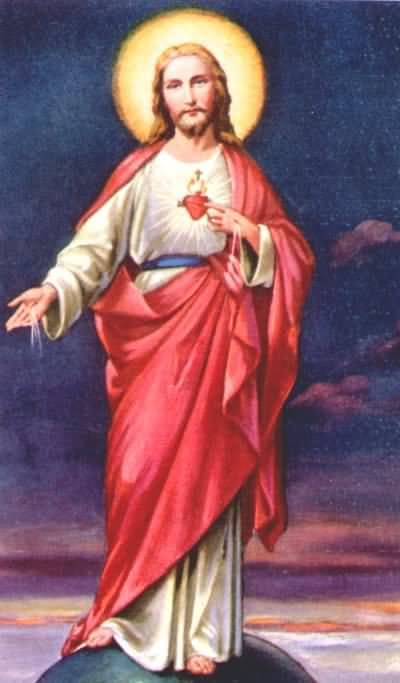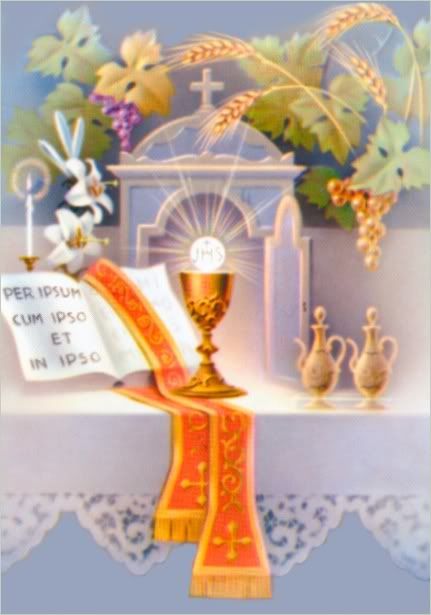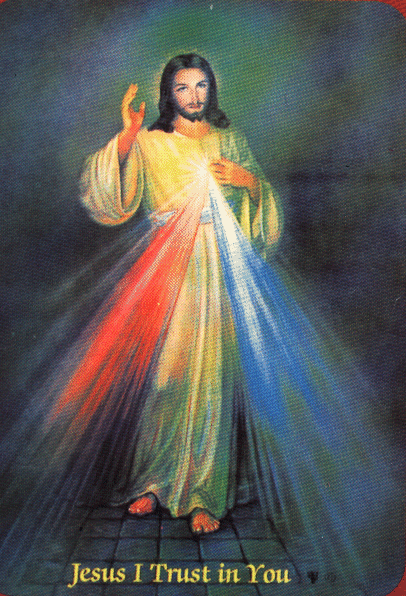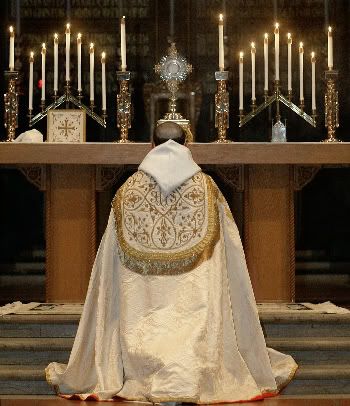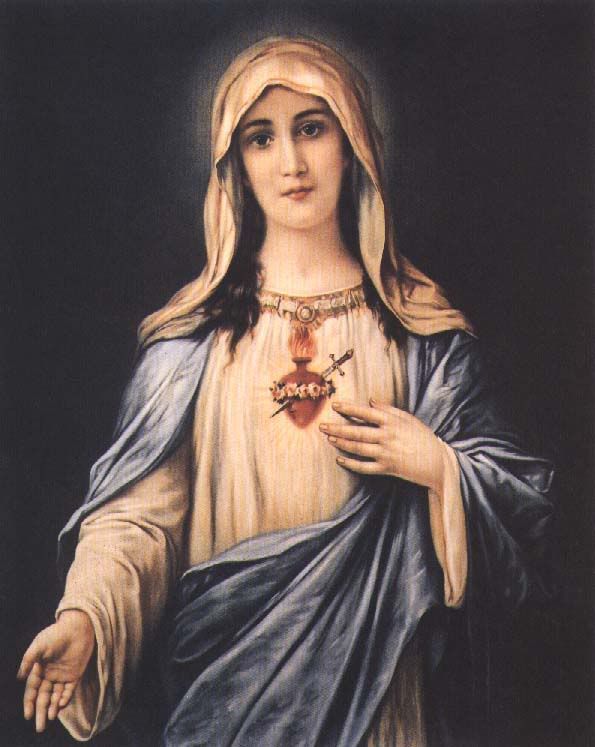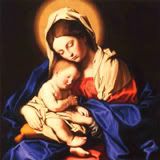Saturday, December 06, 2003
Saint Nicholas
I think we all need something positive and enduring just now. I know I sure do. Today the Church celebrates Saint Nicholas. He is one of the most popular of all the saints. He apparently was born in Lycia. He may have visited the Thebaid, ruled a monastery, spent time imprisoned for the Faith, and died as Archbishop of Myra in present-day Turkey around 324.
Much of what we know about Saint Nicholas appears to be legendary. The story of his restoring to life two children who had been killed and dismembered is probably in this category. There may be more of a basis to the story of the three daughters of the poor man, whom he rescued from a likely life of prostitution by providing dowries for them secretly. The story of his tossing bags of gold through the window of their house is the basis for his role as gift-bringer.
The cult of Saint Nicholas is widespread. He is the patron of sailors, travellers, pawn-brokers, spice-dealers, and, of course, children and young people. The Saint Nicholas Center has more information.
Historian Stephen Nissenbaum, co-author of a ground-breaking work on the Salem Witch Hysteria of 1692, has written a compelling book called The Battle For Christmas, which describes the process of transformation of Saint Nicholas into the figure we now call Santa Claus. The Dutch cult of Saint Nicholas appears not to have migrated to New Amsterdam before the American Revolution. This is because almost all the Dutch immigrants to New York were protestant, not Catholic.
In the 1820s, three patrician protestant New Yorkers combined to create the modern incarnation of the old saint. Washington Irving created elements of this modern myth almost out of whole cloth, though he did draw on Dutch sources.
John Pintard, exasperated by the rowdy, drunken, Carnival-like celebration of Chritmas by the lower classes of New York, began promoting Saint Nicholas first as a patron for New York, and then as a symbol for a domestic celebration of Christmas centered around a gift-bringer and the children of the household.
Clark Clement Moore put all the earlier elements together to give us the image of Santa Claus we are all familiar with. His was the poem known to all now as 'Twas the Night Before Chritmas, but originally titled A Visit From Saint Nicholas.
Later, New Yorker Thomas Nast made Saint Nicholas a full-sized figure. Sundblom (for Coca Cola) and Norman Rockwell (for the Saturday Evening Post) virtually completed the work in the 20th century. Just add in Gene Autry's peripheral tale of Rudolph the Red-Nosed Reindeer, and the modern incarnation of Saint Nicholas is complete.
While much of the Saint Nicholas Day tradition has been grafted unto Christmas, in recent years celebration of Saint Nicholas Day itself has begun to be revived, not instead of Christmas, but in addition to it. It is pleasant to see the original understanding of the saint being restored to some extent.
Happy Saint Nicholas Day!
Much of what we know about Saint Nicholas appears to be legendary. The story of his restoring to life two children who had been killed and dismembered is probably in this category. There may be more of a basis to the story of the three daughters of the poor man, whom he rescued from a likely life of prostitution by providing dowries for them secretly. The story of his tossing bags of gold through the window of their house is the basis for his role as gift-bringer.
The cult of Saint Nicholas is widespread. He is the patron of sailors, travellers, pawn-brokers, spice-dealers, and, of course, children and young people. The Saint Nicholas Center has more information.
Historian Stephen Nissenbaum, co-author of a ground-breaking work on the Salem Witch Hysteria of 1692, has written a compelling book called The Battle For Christmas, which describes the process of transformation of Saint Nicholas into the figure we now call Santa Claus. The Dutch cult of Saint Nicholas appears not to have migrated to New Amsterdam before the American Revolution. This is because almost all the Dutch immigrants to New York were protestant, not Catholic.
In the 1820s, three patrician protestant New Yorkers combined to create the modern incarnation of the old saint. Washington Irving created elements of this modern myth almost out of whole cloth, though he did draw on Dutch sources.
John Pintard, exasperated by the rowdy, drunken, Carnival-like celebration of Chritmas by the lower classes of New York, began promoting Saint Nicholas first as a patron for New York, and then as a symbol for a domestic celebration of Christmas centered around a gift-bringer and the children of the household.
Clark Clement Moore put all the earlier elements together to give us the image of Santa Claus we are all familiar with. His was the poem known to all now as 'Twas the Night Before Chritmas, but originally titled A Visit From Saint Nicholas.
Later, New Yorker Thomas Nast made Saint Nicholas a full-sized figure. Sundblom (for Coca Cola) and Norman Rockwell (for the Saturday Evening Post) virtually completed the work in the 20th century. Just add in Gene Autry's peripheral tale of Rudolph the Red-Nosed Reindeer, and the modern incarnation of Saint Nicholas is complete.
While much of the Saint Nicholas Day tradition has been grafted unto Christmas, in recent years celebration of Saint Nicholas Day itself has begun to be revived, not instead of Christmas, but in addition to it. It is pleasant to see the original understanding of the saint being restored to some extent.
Happy Saint Nicholas Day!
Friday, December 05, 2003
Winter Storm Bears Down On New England
Virginia and parts of Pennsylvania have been socked by this one. Will it bury us under a foot of snow? Will it turn the sidewalks of Boston to a sheet of ice? Will it rain here? How about all of the above? Your guess is as good as mine. If you don't hear from me for a few days, you'll know why.
Wisdom From Dom van Zeller
I was lucky enough to come across a couple of books by Dom Hubert van Zeller, OSB this fall.
Here is one quotation I particularly liked:
"The whole point of mercy is that it goes beyond reason. If God acted on reason alone we would never get to Heaven."
Here is one quotation I particularly liked:
"The whole point of mercy is that it goes beyond reason. If God acted on reason alone we would never get to Heaven."
BC Scrambling To Make An Offer On the Archbishop's Residence
As predicted by just about everybody, land-hungry Boston College is trying to sow up a deal to buy the Brighton property, located diagonally across the street from its lower campus.
Meanwhile, there are other interesting things going on. Neighbors are wary of further Boston College expansion.
And the Archdiocese is making inquiries about moving the body of Cardinal O'Connell from its crypt at the site.
Meanwhile, there are other interesting things going on. Neighbors are wary of further Boston College expansion.
And the Archdiocese is making inquiries about moving the body of Cardinal O'Connell from its crypt at the site.
FYI
If you are in the Boston area, the Revels are performing several times between now and Christmas. This year, they are celebrating a Scottish-themed Christmas. I bought the Victorian Christmas Revels CD two years ago, and enjoyed it greatly.
Advent Ember Week
Just a reminder for those interested. The Ember Week in Advent is the third week in Advent. It always falls on the Wednesday, Friday, and Saturday after December 13th. So not this week, not next week, but the week after.
Today's Precious Blood Leadership Conference Advent Reflection...
The Franciscans Provide A Daily Advent Reflection
The Pew Lady Is Back
After hurting herself. And she has some pertinent comments regarding the bishops, their letter, gay marriage, and VOTF.
Phi Beta Kappa At 227
Today is the 227th anniversary of an organization that I hold in great esteem and am proud to be a member of. On December 5th, 1776, in the Apollo Room of the Raleigh Tavern of Williamsburg, Virginia, William and Mary undergraduates formed Phi Beta Kappa, the nation's oldest undergraduate honors society and the leading honors society devoted to promoting excellence in the liberal arts.
Famous members have included John Quincy Adams, Charles Francis Adams, Henry Adams, Daniel Webster, John Marshall, Joseph Story, Daniel Boorstin, Robert Frost, Nathaniel Hawthorne, Ralph Waldo Emerson, Calvin Coolidge, Theodore Roosevelt, George H.W. Bush, Lynne Cheney, Condoleeza Rice, William Rehnquist, Learned Hand, Henry Kissinger, Dean Rusk, Phyllis Schlafly, Jonas Salk, Caspar Weinberger, Alexander Graham Bell, Mark Twain, Oliver Wendell Holmes, Charles Evans Hughes, Washington Irving, Henry Wadsworth Longfellow, Henry James, Horace Mann, Eli Whitney, William Howard Taft, Avery Cardinal Dulles, Edward Everett Hale, Gale Norton, Irving Babbitt, John C. Calhoun, Richard Henry Dana, James Russell Lowell, Paul Elmer More, George Bancroft, John Greenleaf Whittier, George Santyana, Francis Parkman, Alfred North Whitehead, Jeb Bush, Edward Everett, Henry Cabot Lodge, Booker T. Washington, Carl Sandburg, Bret Harte, Rufus Choate, Oliver Wendell Holmes, Jr., John D. Rockefeller, Jr., and Bernard Baruch among many others.
Lest we be too proud of ourselves, other members include Bill Clinton, Gloria Steinem, Jimmy Carter, Betty Friedan, Kris Kristofferson, Eleanor Smeal, Susan Sontag, Paul Wellstone, and E.J. Dionne.
Even 18 years after admission I am still awed by it (and also by the fact that 18 years have gone by). I just got in by being a whiz at history and taking a great number of classes in my major. I am in no way the generalist many of these famous people are or were, or even in the same ball park as they. Sad to say my education was notably less rigorous than that of people who graduated 50, even 20 years before I did. But it is a thrill to have once been considered worthy of membership in the same organization, even given the dilution of academic standards between their time and my own.
Famous members have included John Quincy Adams, Charles Francis Adams, Henry Adams, Daniel Webster, John Marshall, Joseph Story, Daniel Boorstin, Robert Frost, Nathaniel Hawthorne, Ralph Waldo Emerson, Calvin Coolidge, Theodore Roosevelt, George H.W. Bush, Lynne Cheney, Condoleeza Rice, William Rehnquist, Learned Hand, Henry Kissinger, Dean Rusk, Phyllis Schlafly, Jonas Salk, Caspar Weinberger, Alexander Graham Bell, Mark Twain, Oliver Wendell Holmes, Charles Evans Hughes, Washington Irving, Henry Wadsworth Longfellow, Henry James, Horace Mann, Eli Whitney, William Howard Taft, Avery Cardinal Dulles, Edward Everett Hale, Gale Norton, Irving Babbitt, John C. Calhoun, Richard Henry Dana, James Russell Lowell, Paul Elmer More, George Bancroft, John Greenleaf Whittier, George Santyana, Francis Parkman, Alfred North Whitehead, Jeb Bush, Edward Everett, Henry Cabot Lodge, Booker T. Washington, Carl Sandburg, Bret Harte, Rufus Choate, Oliver Wendell Holmes, Jr., John D. Rockefeller, Jr., and Bernard Baruch among many others.
Lest we be too proud of ourselves, other members include Bill Clinton, Gloria Steinem, Jimmy Carter, Betty Friedan, Kris Kristofferson, Eleanor Smeal, Susan Sontag, Paul Wellstone, and E.J. Dionne.
Even 18 years after admission I am still awed by it (and also by the fact that 18 years have gone by). I just got in by being a whiz at history and taking a great number of classes in my major. I am in no way the generalist many of these famous people are or were, or even in the same ball park as they. Sad to say my education was notably less rigorous than that of people who graduated 50, even 20 years before I did. But it is a thrill to have once been considered worthy of membership in the same organization, even given the dilution of academic standards between their time and my own.
Thursday, December 04, 2003
Red Sox Name Francona Manager
Not the best move that could have been made, I think.
Conservative Episcopalians Are Not Just Getting Over it
Another Bell Grinch Strikes
Contrast Mr. "Ebenezer Scrooge" Coe's attitude to that of Michael Rose, and Deacon Roger Marks in articles in the Adoremus archive.
My view? We need more ringing of church bells, including tolling until midnight on All Hallows' Eve, Christmas Eve, and Holy Saturday.
Thanks to Dale Price for the news story link.
My view? We need more ringing of church bells, including tolling until midnight on All Hallows' Eve, Christmas Eve, and Holy Saturday.
Thanks to Dale Price for the news story link.
Father Wilson On the Latest Dallas Outrage
Whenever Father Wilson is moved to write, you know it will be good.
More Catholic Christmas Shopping Ideas
Chris over at Maine Catholic and Beyond is assembling links on Catholic Christmas shopping. I had previously recommended Ignatius Press. I was leafing through their catalog last night, and found lots of things I'd gladly buy. What a tragedy that a fellow with such wide-ranging interests is crippled with such limited means!
Here are two more. You see the link to Solesmes Abbey on the right? What is that all about, you ask. Well Solesmes is the Benedictine Abbey in France where, more than 100 years ago, they began assembling the greatest collection of Gregorian chant manuscripts in existence. The scholarship and chanted Latin prayers of Solesmes are legendary. You can buy their chant CDs from the Abbey directly. We'll give our ban on things French a rest for this purpose.
The Priestly Fraternity of Saint Peter is known to most of you, I think. It is the papally-sanctioned order that is devoted to saying Mass according to the 1962 Missal. It operates in dioceses with the approval of the local bishop. It is rapidly growing, and turning out new, young traditionalist priests at a rate far in excess of most dioceses. They, too, have things for sale on line. Their seminary's schola has produced several chant CDs, one of which you can listen to on line. They also have a great collection of books, and a lovely calendar featuring the traditional feast days.
Here are two more. You see the link to Solesmes Abbey on the right? What is that all about, you ask. Well Solesmes is the Benedictine Abbey in France where, more than 100 years ago, they began assembling the greatest collection of Gregorian chant manuscripts in existence. The scholarship and chanted Latin prayers of Solesmes are legendary. You can buy their chant CDs from the Abbey directly. We'll give our ban on things French a rest for this purpose.
The Priestly Fraternity of Saint Peter is known to most of you, I think. It is the papally-sanctioned order that is devoted to saying Mass according to the 1962 Missal. It operates in dioceses with the approval of the local bishop. It is rapidly growing, and turning out new, young traditionalist priests at a rate far in excess of most dioceses. They, too, have things for sale on line. Their seminary's schola has produced several chant CDs, one of which you can listen to on line. They also have a great collection of books, and a lovely calendar featuring the traditional feast days.
And Our Daily Advent Reflection From the Precious Blood Leadership Conference
Today's Daily Advent Reflection
Saint Barbara
Today the Church celebrates the 3rd century martyr Saint Barbara. She was the daughter of Dioscorsus, a man of some prominence and wealth. Legend has it that he installed her at the top of a tower, and sent philosophers, orators, and poets to teach her as much as possible. In the course of her studies, she became wiser than her instructors, and saw the folly of polytheism. She sent for Origen, who converted and baptized her. Barbara decided to consecrate herself to God and remain a virgin. She also tossed out of the windows of her tower all the statues of the pagan gods she possessed.
Her father found this blasphemous. He thought of striking her down with his own sword. Instead, he dragged her home by the hair, and brought her before the Prefect Marcian. The Emperor (Maximinus of Thrace) had charged Marcian with the eradication of Christianity. The name of the Emperor helps us pin down an approximate time for her martyrdom. The persecution of Maximinus lasted three years. So we know that Saint Barbara died around 235. He had her beaten with iron rods, torn by iron hooks, and tormented in other manners as well. Since she had not died yet, Dioscorus asked for the honor of killing her. He took her out of town and killed her with an axe.
Barbara has become the protector against death by lightning, sudden explosion, and fire. She has become the patron saint of artillerymen in all the armies of Europe and the Western Hemisphere.
Happy St. Barbara's Day to my friends in the 4th Battalion, Royal Artillery Regiment!
Her father found this blasphemous. He thought of striking her down with his own sword. Instead, he dragged her home by the hair, and brought her before the Prefect Marcian. The Emperor (Maximinus of Thrace) had charged Marcian with the eradication of Christianity. The name of the Emperor helps us pin down an approximate time for her martyrdom. The persecution of Maximinus lasted three years. So we know that Saint Barbara died around 235. He had her beaten with iron rods, torn by iron hooks, and tormented in other manners as well. Since she had not died yet, Dioscorus asked for the honor of killing her. He took her out of town and killed her with an axe.
Barbara has become the protector against death by lightning, sudden explosion, and fire. She has become the patron saint of artillerymen in all the armies of Europe and the Western Hemisphere.
Happy St. Barbara's Day to my friends in the 4th Battalion, Royal Artillery Regiment!
Archbishop's Residence On the Block
This takes no one by surprise. Once Archbishop Sean had vacated the premises, it was very likely that the Archdiocese would put the Taj O'Connell up for sale.
From a triumphalist and aesthetic standpoint, of course this is not a good thing. The Archbishop's residence is beautiful and speaks to the importance and permanance of Christ's One, Holy, Catholic, and Apostolic Church in Boston. But that is the only standpoint from which it is a tragedy.
But from a practical standpoint, it is quite reasonable to part with the place. BC is very willing to part with lots of cash for the place, and there may be other suitors as well. The Archdiocese has a huge legal bill to pay, and the participation of the insurers is questionable. So parting with a very valuable asset that could nearly pay all the costs itself, or at least 50% of them, is not only reasonable, but necessary.
What we are dealing with here are the consequences of sin. Fail to protect children from perverts for a long time, and in fact protect and coddle the perverts, and a price must be paid. The Archbishop's Residence has become a symbol of what is wrong with the Archdiocese of Boston: a grand structure with no idea what is going on, and little inclination to make things better. The failure rested with Cardinals Cushing, Medieros, and Law and their staffs. Therefore, there is a certain raw justice in the Archdiocese paying the price of sacrificing the magnificent palace that housed Boston's prelates.
The Church can thrive without the palace in Brighton. Some of the greatest growth in its history came before the palace was built. Other sees function without their prelates ensconced in the lap of luxury. The Archdiocese will do just fine without it. Therefore, selling it to compensate the perverts' numerous victims seems fitting and proper, dulce et decorum.
From a triumphalist and aesthetic standpoint, of course this is not a good thing. The Archbishop's residence is beautiful and speaks to the importance and permanance of Christ's One, Holy, Catholic, and Apostolic Church in Boston. But that is the only standpoint from which it is a tragedy.
But from a practical standpoint, it is quite reasonable to part with the place. BC is very willing to part with lots of cash for the place, and there may be other suitors as well. The Archdiocese has a huge legal bill to pay, and the participation of the insurers is questionable. So parting with a very valuable asset that could nearly pay all the costs itself, or at least 50% of them, is not only reasonable, but necessary.
What we are dealing with here are the consequences of sin. Fail to protect children from perverts for a long time, and in fact protect and coddle the perverts, and a price must be paid. The Archbishop's Residence has become a symbol of what is wrong with the Archdiocese of Boston: a grand structure with no idea what is going on, and little inclination to make things better. The failure rested with Cardinals Cushing, Medieros, and Law and their staffs. Therefore, there is a certain raw justice in the Archdiocese paying the price of sacrificing the magnificent palace that housed Boston's prelates.
The Church can thrive without the palace in Brighton. Some of the greatest growth in its history came before the palace was built. Other sees function without their prelates ensconced in the lap of luxury. The Archdiocese will do just fine without it. Therefore, selling it to compensate the perverts' numerous victims seems fitting and proper, dulce et decorum.
Wednesday, December 03, 2003
I Do One Blog On Toy Soldiers...
And suddenly all the Catholic stuff in my advertising is gone, replaced by toy soldier company ads, including the excellent Michigan Toy Soldier Company and Classic Toy Soldiers firms.
Well, I hope it generates business for them. God speed their commerce. Toy soldiers make great gifts for young boys, or older boys, too. And both of the firms that I have seen advertising on my site this morning are highly reputable and with excellent inventories.
What will happen when I blog about cigars or single malt whisky? What would happen if I ever did a blog about some pop celebrity like Michael Jackson or Britney Spears?
Well, I hope it generates business for them. God speed their commerce. Toy soldiers make great gifts for young boys, or older boys, too. And both of the firms that I have seen advertising on my site this morning are highly reputable and with excellent inventories.
What will happen when I blog about cigars or single malt whisky? What would happen if I ever did a blog about some pop celebrity like Michael Jackson or Britney Spears?
Advent Reflections In Booklet Form
I've been reading Day By Day Through Advent by Father Daniel Lowery. It was published by Ligouri. There are citations for today's Scripture readings, and commentary based on one, together with a prayer and a suggested course of action. Very good Advent preparation.
Daily Advent Reflection
From the Precious Blood Leadership Conference. You have to scroll down to today's reflection, as Father keyes pointed out below.
Saint Francis Xavier
Today the Church celebrates Saint Francis Xavier. Francis was a 32 year old professor of philosophy at the University of Paris when he met Saint Ignatius of Loyola. He became a Jesuit. Denied the ability to sail for the Holy Land, he preached in Italy, and then Portugal. He saw an opportunity for missionary work on a grand scale, and embarked for Goa in 1542.
In India, Francis Xavier baptized no less than 40,000 Palawars. He established churches, schools and colleges wherever he went. He may have exercised the gift of tongues in Travancore, and may even have raised some people from the dead. We went to Japan for 28 months, and made many converts there. Returning to Goa, he prepared himself for what he hoped would be an equally fruitful mission to China. He fell ill during the voyage, and died on the island of Sancian in sight of Canton on December 2nd, 1552. It may be an overstatement, but some have estimated that he converted over 1 million souls.
The lay teaching order of the Xaverian Brothers was named for St. Francis Xavier. The order maintains several excellent secondary schools in Massachusetts, including my alma mater, Saint John's Preparatory School. I owe a great deal to the fine education provided by Brothers Robert Daily (history, freshman and sophmore years), Thomas Pucchio (English, junior year, and my debate team coach), Chad Nudd (religion, freshman year, the only decent religious instruction I received there), Joseph Comber (Latin, all four years), Phillip De Marchi (chemistry, junior year: I was terrible at it), David Mahoney (English, freshman year), Robert Sullivan (physics, senior year; again I was abysmal) and Tim Paul (biology, freshman year). Many of them are no longer teaching, or are at another Xaverian-run school now. Brother Chad, I know, died some years ago. But Saint Francis Xavier was the inspiration for their order. I wish them joy of the day, and thank them for what they did for me.
In India, Francis Xavier baptized no less than 40,000 Palawars. He established churches, schools and colleges wherever he went. He may have exercised the gift of tongues in Travancore, and may even have raised some people from the dead. We went to Japan for 28 months, and made many converts there. Returning to Goa, he prepared himself for what he hoped would be an equally fruitful mission to China. He fell ill during the voyage, and died on the island of Sancian in sight of Canton on December 2nd, 1552. It may be an overstatement, but some have estimated that he converted over 1 million souls.
The lay teaching order of the Xaverian Brothers was named for St. Francis Xavier. The order maintains several excellent secondary schools in Massachusetts, including my alma mater, Saint John's Preparatory School. I owe a great deal to the fine education provided by Brothers Robert Daily (history, freshman and sophmore years), Thomas Pucchio (English, junior year, and my debate team coach), Chad Nudd (religion, freshman year, the only decent religious instruction I received there), Joseph Comber (Latin, all four years), Phillip De Marchi (chemistry, junior year: I was terrible at it), David Mahoney (English, freshman year), Robert Sullivan (physics, senior year; again I was abysmal) and Tim Paul (biology, freshman year). Many of them are no longer teaching, or are at another Xaverian-run school now. Brother Chad, I know, died some years ago. But Saint Francis Xavier was the inspiration for their order. I wish them joy of the day, and thank them for what they did for me.
A Daily Advent Relection From the Franciscans
Tuesday, December 02, 2003
The Original The Little Drummer Boy by the Harry Simeone Chorale
I was looking at archived material from last year, and happened to notice that someone had left a comment last month regarding the availability of the original The Little Drummer Boy CD by the Harry Simeone Chorale. I mentioned it in a list of my favorite Christmas CDs.
I bought it through special order at Border's last November (2002). But it is also available through Amazon.com here.
Confusingly, the HSC produced, to my knowledge, 3 Christmas albums, and they were all titled The Little Drummer Boy. But this one is the original, with all religious music, including the fine Negro spiritual "Go Tell It On the Mountain" along with a host of traditional European carols. The one sold at the Amazon link is the one we grew up with.
I bought it through special order at Border's last November (2002). But it is also available through Amazon.com here.
Confusingly, the HSC produced, to my knowledge, 3 Christmas albums, and they were all titled The Little Drummer Boy. But this one is the original, with all religious music, including the fine Negro spiritual "Go Tell It On the Mountain" along with a host of traditional European carols. The one sold at the Amazon link is the one we grew up with.
Winter Is Here
This morning we had a line of sharp snow squalls come through. This was our first significant snow, though it only amounted to a dusting. The temperature, which has been bearable recently, is not expected to get above freezing today. Thanksgiving Day was sunny and mild, with temperatures well above 50 degrees.
Our fall was wet, but temperate. Now December is ushering winter in, just about on cue. Many have speculated that this will be a snowy and cold winter. But the fact that we had no real snow until now makes me, at least, hopeful of a mild, short winter.
But we in New England were spoiled in the mid-late '90s and into the 21st century. Two winters ago, there was scarcely any need for the heavy winter coats at all. And I can fondly recall an early December Sunday or two with temperatures in the 60s and 70s that I used to gather Christmas greens in the woods and waste near my old home, and fashion them into garlands for the door. But there is none of such mild weather in the forecast for the coming week.
Last winter, with cold and significant snow, came as an unpleasant reminder of New England reality.
I ask you, is there any place in the US where the temperature stays at 60-75 degrees year-round with little humidity? If there is such a place, I would consider relocating to it.
I'm now much too old to enjoy snow, ice, and cold (especially with two trick knees). And I'm not a fan of heat and humidity, though air conditioning, which is pretty universal here, does much to solve that problem.
Still, in New England, we get roughly 6 good months each year (April, May, June, September, October, November). December and March are often tolerable. There is no predictable "rainy season," though we get a fair amount of rain year-round. The worst of the snow and ice is usually mid-January-late February. The worst of the summer heat and humidity is in July and August. There is probably no other place that is pleasant for so much of the time.
But this December may not be a tolerable one, if this morning was any indication. It's time for us to suck it up and remember that New England weather used to be a lot more harsh than it has been in the last decade.
There was more than hot air and the improvments of memory in our elders' stories of wading four miles through snow drifts to go to school in Novembers and Marchs past. Is our stock grown so degenerate that we can't handle a dusting of snow and temperatures in the 20s in December?
Well, mine has. If someone were to offer me accomodations in Florida from now until Easter, I'd be there, and come back with the Red Sox in April.
Our fall was wet, but temperate. Now December is ushering winter in, just about on cue. Many have speculated that this will be a snowy and cold winter. But the fact that we had no real snow until now makes me, at least, hopeful of a mild, short winter.
But we in New England were spoiled in the mid-late '90s and into the 21st century. Two winters ago, there was scarcely any need for the heavy winter coats at all. And I can fondly recall an early December Sunday or two with temperatures in the 60s and 70s that I used to gather Christmas greens in the woods and waste near my old home, and fashion them into garlands for the door. But there is none of such mild weather in the forecast for the coming week.
Last winter, with cold and significant snow, came as an unpleasant reminder of New England reality.
I ask you, is there any place in the US where the temperature stays at 60-75 degrees year-round with little humidity? If there is such a place, I would consider relocating to it.
I'm now much too old to enjoy snow, ice, and cold (especially with two trick knees). And I'm not a fan of heat and humidity, though air conditioning, which is pretty universal here, does much to solve that problem.
Still, in New England, we get roughly 6 good months each year (April, May, June, September, October, November). December and March are often tolerable. There is no predictable "rainy season," though we get a fair amount of rain year-round. The worst of the snow and ice is usually mid-January-late February. The worst of the summer heat and humidity is in July and August. There is probably no other place that is pleasant for so much of the time.
But this December may not be a tolerable one, if this morning was any indication. It's time for us to suck it up and remember that New England weather used to be a lot more harsh than it has been in the last decade.
There was more than hot air and the improvments of memory in our elders' stories of wading four miles through snow drifts to go to school in Novembers and Marchs past. Is our stock grown so degenerate that we can't handle a dusting of snow and temperatures in the 20s in December?
Well, mine has. If someone were to offer me accomodations in Florida from now until Easter, I'd be there, and come back with the Red Sox in April.
Another Daily Advent Reflection
Today's Advent Reflection
From AmericanCatholic.org.
Everyone Had Seen This Coming Since June
Except the majority of the Supreme Court's justices. Like so many, I ask, if not gay sex, why not polygamy or polyamory? Why not bestiality? Why not incest? Why not "liberate" sex with the underage?
Now we are being offered another bitter draught from the brew the Supreme Court prepared for our society. I suppose they will find a weasel-way, a distinction without a difference, to prevent this from being the law of the land for now, but in doing so leave wiggle room for future courts to explore the frontiers of sexual liberation yet further.
Now we are being offered another bitter draught from the brew the Supreme Court prepared for our society. I suppose they will find a weasel-way, a distinction without a difference, to prevent this from being the law of the land for now, but in doing so leave wiggle room for future courts to explore the frontiers of sexual liberation yet further.
Monday, December 01, 2003
The Jesse Tree
Today's Advent Reflection
From the Confraternity of the Precious Blood.
Christmas Lists
I will admit to being a "list Nazi." At no time of year does my list-making take on greater significance than at the run-up to Christmas. I make lists of groceries for cookie baking, Christmas meals, and New Years, and shopping lists of gifts arranged by store, by recipient, and by dollar amount. In my youth, I used to be able to buy gifts for 9 people (4-10 gifts for each), from a dozen stores, get them home and wrap them in one day, because I knew just what I was going to buy, where, and how much I would spend. Middle age has slowed me down a bit. But I still live by my lists at this time of year.
Between now and Christmas, I'll be giving you some lists I drew up for fun and contemplation. Here is one to start off with:
Favorite Christmas Reading
St. Luke's Gospel, Chapter 2
This is the Christmas story. I read it privately several times during Advent, and as part of our Christmas ritual after dinner on Christmas Eve.
Charles Dickens, A Christmas Carol
Charles Dickens and his generation revivified Christmas. It takes a couple of hours to read through the original text. There are many fine screenplays, but take the time to read the original.
Washington Irving, The Bracebridge Hall stories
Mince pies, a whimsical squire bent on restoring ancient Christmas customs on his ancestral lands, a stranger given Christmas entertainment, a parson preaching against Cromwellian attacks on Christmas (in 1820), holly and ivy, wassail bowls, the boar's head, harp in hall, mistletoe, masquing. Young people read The Legend of Sleepy Hollow and Rip Van Winkle. They should get to know Squire Bracebridge, and renew the acquaintance annually.
Dylan Thomas, A Child's Christmas In Wales
Thomas wrote this poem in prose about his childhood Christmas experience. Parts of it are common to all of us. This is a very short read (under an hour). There was a fine television adaptation some years ago, that is unfortunately hard to find today.
Karen Cure, An Old-Fashioned Christmas
This was a selection from the Conservative Book Club back in the 1980s. It explores in detail Christmas at Williamsburg, at Mark Twain's Hartford home, at Greenfield Village. This is a how-to book on celebrating an old-fashioned Christmas. If you find yourself lacking solid family Christmas traditions, give this a read to find ones you can adopt.
Linda Clements, The Spirit of Christmas Past
This is an English version of An Old Fashioned Christmas. We read here much more about holly and ivy, how crackers came about and why, and the Yule Log. There are also synopses of the rules of Victorian parlor games, like the Minister's Cat.
Aloise Buckley Heath, "It Says Here", published periodically at Christmas by National Review.
NR publishes this one every few years in rotation with other Christmas pieces by WFB's late sister. I saved my back-issues from 1981 on. It is a heart-warming story of an obviously affluent and large family preparing for Christmas morning.
Henry Van Dyke, The Fourth Wise Man
A story of faith and perseverence. Artaban went with his fellow mages in search of the new-born King of the Jews. He was separated from them, and wandered for 33 years in search of the Christ, only finding Him on Calvary.
Jim Bishop, The Day Christ Was Born
This story lacks the detailed historical information of The Day Christ Died. But Bishop does a nice job putting the events connected with the Incarnation into sequence.
Stephen Nissenbaum, The Battle For Christmas
How Victorians recreated Christmas and why. By the 18th century, Christmas was largely Carnival, a rowdy drunken time of licentiousness and politically dangerous role-inversion. It resembled in many ways modern Halloween, had been banned, and was in danger of going the way of Lammas and Michaelmas. Within a few years, Saint Nicholas/Santa Claus/Father Christmas, Christmas shopping on a grand scale, the Christmas tree, the Christmas card, Dickens' A Christmas Carol, and most of the carols we sing today, all came into prominence both in the US and the UK. Christmas became a cherished domestic holiday.
The most important preparation for Christmas is readying the mind and the heart to welcome the Saviour. For Advent preparation, I've been reading Father Mark Boyer's Follow the Star, but am not entirely satisfied. I'm open to suggestions for good Advent reading. I have lent covered now, but my Advent reading is still not what I would like it to be.
Between now and Christmas, I'll be giving you some lists I drew up for fun and contemplation. Here is one to start off with:
Favorite Christmas Reading
St. Luke's Gospel, Chapter 2
This is the Christmas story. I read it privately several times during Advent, and as part of our Christmas ritual after dinner on Christmas Eve.
Charles Dickens, A Christmas Carol
Charles Dickens and his generation revivified Christmas. It takes a couple of hours to read through the original text. There are many fine screenplays, but take the time to read the original.
Washington Irving, The Bracebridge Hall stories
Mince pies, a whimsical squire bent on restoring ancient Christmas customs on his ancestral lands, a stranger given Christmas entertainment, a parson preaching against Cromwellian attacks on Christmas (in 1820), holly and ivy, wassail bowls, the boar's head, harp in hall, mistletoe, masquing. Young people read The Legend of Sleepy Hollow and Rip Van Winkle. They should get to know Squire Bracebridge, and renew the acquaintance annually.
Dylan Thomas, A Child's Christmas In Wales
Thomas wrote this poem in prose about his childhood Christmas experience. Parts of it are common to all of us. This is a very short read (under an hour). There was a fine television adaptation some years ago, that is unfortunately hard to find today.
Karen Cure, An Old-Fashioned Christmas
This was a selection from the Conservative Book Club back in the 1980s. It explores in detail Christmas at Williamsburg, at Mark Twain's Hartford home, at Greenfield Village. This is a how-to book on celebrating an old-fashioned Christmas. If you find yourself lacking solid family Christmas traditions, give this a read to find ones you can adopt.
Linda Clements, The Spirit of Christmas Past
This is an English version of An Old Fashioned Christmas. We read here much more about holly and ivy, how crackers came about and why, and the Yule Log. There are also synopses of the rules of Victorian parlor games, like the Minister's Cat.
Aloise Buckley Heath, "It Says Here", published periodically at Christmas by National Review.
NR publishes this one every few years in rotation with other Christmas pieces by WFB's late sister. I saved my back-issues from 1981 on. It is a heart-warming story of an obviously affluent and large family preparing for Christmas morning.
Henry Van Dyke, The Fourth Wise Man
A story of faith and perseverence. Artaban went with his fellow mages in search of the new-born King of the Jews. He was separated from them, and wandered for 33 years in search of the Christ, only finding Him on Calvary.
Jim Bishop, The Day Christ Was Born
This story lacks the detailed historical information of The Day Christ Died. But Bishop does a nice job putting the events connected with the Incarnation into sequence.
Stephen Nissenbaum, The Battle For Christmas
How Victorians recreated Christmas and why. By the 18th century, Christmas was largely Carnival, a rowdy drunken time of licentiousness and politically dangerous role-inversion. It resembled in many ways modern Halloween, had been banned, and was in danger of going the way of Lammas and Michaelmas. Within a few years, Saint Nicholas/Santa Claus/Father Christmas, Christmas shopping on a grand scale, the Christmas tree, the Christmas card, Dickens' A Christmas Carol, and most of the carols we sing today, all came into prominence both in the US and the UK. Christmas became a cherished domestic holiday.
The most important preparation for Christmas is readying the mind and the heart to welcome the Saviour. For Advent preparation, I've been reading Father Mark Boyer's Follow the Star, but am not entirely satisfied. I'm open to suggestions for good Advent reading. I have lent covered now, but my Advent reading is still not what I would like it to be.
Today's Advent Reflection
From American Catholic.org.
Requiescat In Pace
The world of literary criticism lost one of its giants last week. Hugh Kenner, who I must admit I mostly know from frequent appearances on Firing Line with Bill Buckley, died on the 26th at the age of 80. Kenner wrote wisely on Eliot and Pound, but also championed Beckett and Joyce. Requiescat in pace.
Sunday, November 30, 2003
This Advent
In November the Church directs its attention to the souls of the departed. In Advent we turn to preparation for the coming of the Lord. Advent is a time of joyful waiting. It is a penitential season, but not as deeply sorrowful as Lent.
We are waiting for a joyful thing. There is no Good Friday in Advent, nothing close. Therefore, it is right that our hearts be joyful, if some of the joy of Christmas seeps through to Advent. We have work to do preparing the way of the Lord in our hearts.
Here at Recta Ratio, I hope to be looking at God's love and Christian love during Advent. This season which culminates in a birth in a stable and gifts for a new-born King is the season of love. I will be looking at what various writers have had to say on the topic. This will be a learning experience for me, so bear with me.
May this Advent be a useful and happy preparation for all of us.
We are waiting for a joyful thing. There is no Good Friday in Advent, nothing close. Therefore, it is right that our hearts be joyful, if some of the joy of Christmas seeps through to Advent. We have work to do preparing the way of the Lord in our hearts.
Here at Recta Ratio, I hope to be looking at God's love and Christian love during Advent. This season which culminates in a birth in a stable and gifts for a new-born King is the season of love. I will be looking at what various writers have had to say on the topic. This will be a learning experience for me, so bear with me.
May this Advent be a useful and happy preparation for all of us.
Daily Advent Reflections
From AmericanCatholic.org.
Prayer For Lighting the First Candle
Starting An Advent Retreat
Father Keyes over at The New Gasparian is starting an online Advent retreat today. It is well worth examining.
Saint Andrew's Night
The feast of Saint Andrew is one of the four saints' days commemorated in the messes of the British army. Andrew is the patron of Scotland. Saint George (April 23rd) is the patron of England. Saint David (March 1st) is the patron of Wales. Saint Patrick, of course, is the patron of Ireland. Saint Andrew's Day is the only one of the four not in late-winter/early-spring.
Because of my re-enacting experience, I am either a member of, or have been a guest of, the messes of regiments of all four major ethnic groups. I have dined with the Royal Welch Fusileers (23rd Regiment of Foot) officers' mess on March 1st, with the Friendly Brothers of Saint Patrick on March 17th, with the officers' mess of the Black Watch (Royal Highland Regiment, or 42nd Regiment of Foot) on November 30th, and with the Loyal and Friendly Society of the Blue and Orange on April 23rd. These evenings are convivial occasions, with a formal dinner, many, many toasts, and seemingly eccentric regimental customs. You would not want to drive yourself home after one of these dinners.
Re-enactor officers are just being true to the characters they portray in these celebrations. John Peebles, an officer of the grenadier company of the 42nd Regiment celebrated St. Andrew's Night thus in his New York-area garrison in 1779:
Went to town to celebrate the day with his Ex (he mounted a round blue device with a white Saint Andrew's cross in his regulation highland bonnet-GTF): where the field offs. & Capts. of the 42nd. were invited , the Adml. there the offrs. of the Royal Highland emigrants & some others, about 24 in all. Major Small personated the Saint who gave very good toasts & apropos for the occasion. The Adml. very chatty & entertaining. Major Hay sang some good songs & spouted a prologue very well. A good dinner & drink till 10 o'clock. A numerous party of the Sons of St. Andw. din'd at Hick's above 60, among whom were the subs. (subalterns: lieutenants and ensigns- GTF) of the 42d. Exchanged a complit. & some of our Compy. join'd them after we broke up, & made a night of it.
John Peebles' American War 1776-1782, edited by Ira Gruber, 1997.
I wish my Scottish friends a happy Saint Andrew's Day, with much enjoyment of haggis and that amber-coloured beverage distilled in the Highlands.
Because of my re-enacting experience, I am either a member of, or have been a guest of, the messes of regiments of all four major ethnic groups. I have dined with the Royal Welch Fusileers (23rd Regiment of Foot) officers' mess on March 1st, with the Friendly Brothers of Saint Patrick on March 17th, with the officers' mess of the Black Watch (Royal Highland Regiment, or 42nd Regiment of Foot) on November 30th, and with the Loyal and Friendly Society of the Blue and Orange on April 23rd. These evenings are convivial occasions, with a formal dinner, many, many toasts, and seemingly eccentric regimental customs. You would not want to drive yourself home after one of these dinners.
Re-enactor officers are just being true to the characters they portray in these celebrations. John Peebles, an officer of the grenadier company of the 42nd Regiment celebrated St. Andrew's Night thus in his New York-area garrison in 1779:
Went to town to celebrate the day with his Ex (he mounted a round blue device with a white Saint Andrew's cross in his regulation highland bonnet-GTF): where the field offs. & Capts. of the 42nd. were invited , the Adml. there the offrs. of the Royal Highland emigrants & some others, about 24 in all. Major Small personated the Saint who gave very good toasts & apropos for the occasion. The Adml. very chatty & entertaining. Major Hay sang some good songs & spouted a prologue very well. A good dinner & drink till 10 o'clock. A numerous party of the Sons of St. Andw. din'd at Hick's above 60, among whom were the subs. (subalterns: lieutenants and ensigns- GTF) of the 42d. Exchanged a complit. & some of our Compy. join'd them after we broke up, & made a night of it.
John Peebles' American War 1776-1782, edited by Ira Gruber, 1997.
I wish my Scottish friends a happy Saint Andrew's Day, with much enjoyment of haggis and that amber-coloured beverage distilled in the Highlands.
Saint Andrew
Today, the Church celebrates Saint Andrew, brother of Simon Peter, disciple of John the Baptist, and apostle of the Lord. Andrew was a fisherman from Capharnaum. He was with John the Baptist at the time of the baptism of Jesus, and followed Him from that time, later bringing Peter into the fold of the apostolic college. It was Andrew who reported the state of the food supply to the Lord before the feeding of the five thousand. But ortherwise, he appears to have faded into the apostolic group.
Andrew exercised his ministry in the region of the Black Sea, and was crucified on an "X" form crucifix at Patras in Achaia. He is the patron of fishermen and fishmongers, as well as patron of Scotland.
Andrew exercised his ministry in the region of the Black Sea, and was crucified on an "X" form crucifix at Patras in Achaia. He is the patron of fishermen and fishmongers, as well as patron of Scotland.


